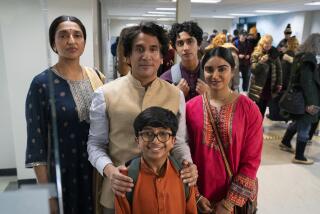The Young Voices of Nair’s ‘Bombay’ : A woman of privilege paints a vivid portrait of street urchins
Mira Nair’s “Salaam Bombay!,” surprise smash hit and Camera D’Or winner at the last Cannes Film Festival, is a brilliant, passionate new film that gives us Indian city life in ways we rarely see it. Much as Hector Babenco (“Pixote”), Francois Truffaut (“The 400 Blows”) and Bunuel (“Los Olvidados”) before her, Nair shows us her city through the eyes of its youth: the homeless street urchins, some as young as 4, who crowd Bombay’s streets by the thousands.
But Nair herself is no urchin. Dark-haired, saucy, with an impishly lovely smile, she’s the 31-year-old daughter of an Indian civil servant in Orissa, the product of an “enchanted childhood.” She’s also a Harvard graduate, ex-stage actress and award-winning documentary film maker. And she’s married to an American, her co-producer and production designer Mitch Epstein, with whom she lives on Rivington Street in the heart of New York’s storied Bowery.
Her conversation, fluid and funny, is laced with sophisticated vernacular and easy laughs. She has an urbane outlook. Jerzy Grotowski and Peter Brook were her theatrical idols; her favorite film-maker is Jean Renoir (“The Rules of the Game”), and her favorite writers include Nadine Gordimer, V. S. Naipaul and Milan Kundera.
Yet this cosmopolitan Indian emigre obviously intensely identifies with her subjects. All of the street children in “Salaam Bombay!”--from star Shafiq Syed to the smallest bit part--are played, not by child actors, but by street children. “The whole time I had the idea from this movie, I knew I was going to use kids from the street,” Nair says. “It was their quality of agelessness that inspired the thing in the first place. And also because their faces and their bodies were really maps of their journey. We had this one scene, written but not in the movie, about a kid telling you his whole history by the scars on his leg.
Bombay Dreams
“Having made a few documentaries in Bombay, I always noticed the vitality of these kids, at every street corner. I remember once being surrounded by them--in a taxi. . . . These kids come from all over India. Bombay is like the stuff of dreams: where dreams are spun.”
In life, many of the children ultimately return to their villages. Some are swallowed up into the city. Nair got to know them partly through her co-writer Sooni Taraporevala, who lives two blocks from the red-light district where much of the film was shot. “We spent a fair amount of time going to movies, playing cards, hanging out with them. Actually, very few of them beg. There’s a great law of the gutter about not begging. . . . We also talked to kids in railway platforms, in brothels, in prisons. I gained access to the same prison, the Chili Room, that we shot in the movie . . . where we interviewed about 70 children.”
Finally, after a year of scriptwriting and research, Nair and her co-workers--including Sooni, actor Raghubir Yadav (who movingly plays the hashish addict, Chillum) and Dehli theater director Barry John--assembled a group of 130 children for the six-week workshop. It included classes in dance, exercise, yoga, improvisation, mime, and debate. “We auditioned down to 24 kids in the first week and worked with them for six weeks: nine hours a day, six days a week. . . . This workshop not only ‘trained’ the kids, but also ourselves, in a way. And it let us embellish the script by working intimately with the children.”
“While we were shooting, there was an atmosphere of such. . . . We were so alive, in this story, I think they rapidly began to feel it was their story.”
Shafiq Syed plays the lead role of Krishna, a 10-year-old abandoned in Bombay and forced to fend for himself among prostitutes, pimps and drug pushers: a luminous child portrayal, in the tradition of Enzo Staiola (“Bicycle Thieves”), Jean-Pierre Leaud (“The 400 Blows”), Brigitte Fossey (“Forbidden Games”)--and “Pixote’s” Fernando Ramos Da Silva. And his life uncomfortably parallels Da Silva’s: a tragic youth who was shot by police in Rio on the day before production began on “Salaam Bombay!”
Shafiq was only 10, and a ragpicker working on Grant Bridge, when he was cast. When he was 9, his father, an alcoholic bicycle shop worker, once chained him to the shop; that some day he hopped a train for Bombay, still wearing the bicycle chain. Since the movie, he has been placed in a school, dropped out, quit a job as messenger for a film company and is now working with a Dehli theater group.
Says Nair: “Our intentions were never to be guilty liberals or missionaries or anything, but to have the kids determine what they wanted to do with their lives. The thing we’ve learned, though, is that it’s very hard for a street child to learn how to read and write.
Are there parallels between the Bombay of her film and New York City, where she now lives? Nair nods vigorously. “Very much so. I feel that this film could easily be ‘Salaam, Bronx!’ Except it would be much more disturbing if it were in the Bronx.
“I’m now pretty entrenched in the street scene in India. But when I talk to people in the Bowery, or when I read about kids in Grand Central shooting themselves at the age of 14--which happened just last Sunday--I see a quality of deep-seated aloneness in those people’s lives. I see a quality of being completely alienated at age 14, from family and the world, that is just so devastating.
“That kind of alienation I haven’t yet encountered in India. There is a difficulty, there is horrific poverty, there’s a the density of millions of people. . . . But there is a kind of--and I don’t like to use these schlocky type of words--but there is somehow a kind of humanity that transcends it. . . .”
Nair, who is now working on her first English-language feature, set in Uganda and the American South, sometimes reminds you of her street children: bubbling with enthusiasm and hope, in the midst of harsh, dangerous conditions. “Life is so interesting! The arbitrariness, the things people do. Truth is much stranger than fiction. If you can marry the two and make fiction out of it--You know, I use truth loosely as what you see and experience--it’s just much more fascinating.”
More to Read
Only good movies
Get the Indie Focus newsletter, Mark Olsen's weekly guide to the world of cinema.
You may occasionally receive promotional content from the Los Angeles Times.










